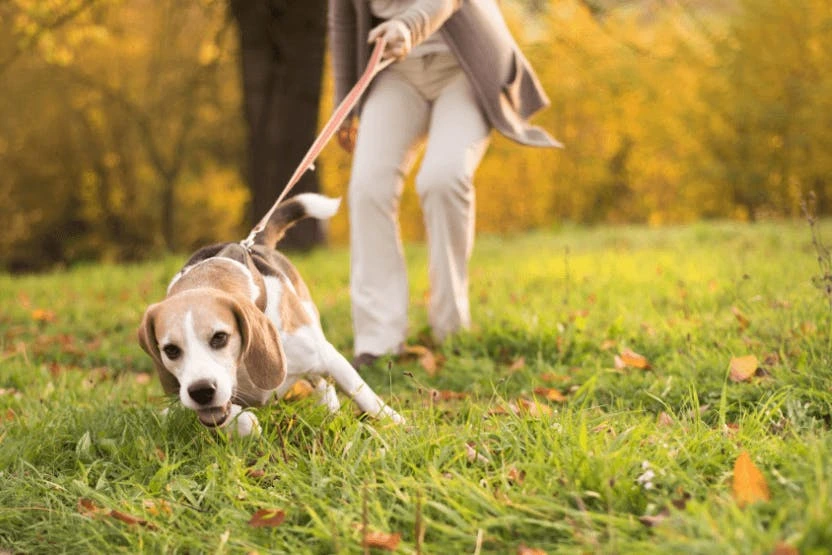Walking your dog should be an enjoyable experience for both you and your furry companion. However, if your dog pulls on the lead, it can turn into a frustrating outing. Fortunately, with consistent training and patience, you can teach your dog to walk politely on a leash.
Understanding Why Dogs Pull on the Lead
Before diving into solutions, it’s essential to understand why dogs pull on the lead in the first place. Here are a few common reasons:
-
Excitement: Dogs are naturally curious and excited by their surroundings. When they see something interesting—like another dog, a person, or a squirrel—they tend to pull forward.
-
Lack of Training: Some dogs may not have learned proper leash etiquette. They may not understand that pulling is not the desired behavior.
-
Instinct: Certain breeds have a higher prey drive or are more energetic, which may lead to pulling when they sense something they want to chase.
-
Desire to Explore: Dogs are explorers by nature. If they want to investigate an intriguing smell or object, they may pull to get closer.
Training Techniques to Stop Pulling
Here are several effective methods to train your dog not to pull on the lead:
1. Choose the Right Equipment
Using the right equipment can make a significant difference in managing your dog's pulling behavior:
- Harnesses: A front-clip harness can help redirect your dog when they pull, as it brings them back to your side rather than allowing them to pull forward.
- Leads: A shorter lead (4 to 6 feet) can provide better control compared to a longer one, which may encourage pulling.
2. Positive Reinforcement Training
Positive reinforcement is one of the most effective training methods. Here's how to implement it:
- Reward Good Behavior: Whenever your dog walks beside you without pulling, reward them with treats, praise, or playtime. The idea is to reinforce the behavior you want to see.
- Stop and Go: If your dog starts to pull, stop walking. Wait until your dog comes back to you or loosens the lead before continuing. This teaches them that pulling will not get them anywhere.
3. Use the "Leave It" Command
Teaching your dog the “leave it” command can help manage their impulse to pull towards distractions. Here’s how:
- Practice Indoors: Start by holding a treat in your hand and saying “leave it” while keeping your hand closed. When your dog stops trying to get the treat, praise them and offer a different treat from your other hand.
- Apply Outdoors: Use the same command when out on walks. When your dog notices a distraction, say “leave it,” and reward them for focusing on you instead.
4. Practice Loose-Leash Walking
Training your dog to walk on a loose lead requires practice and consistency:
- Start in a Controlled Environment: Begin training in a quiet area with minimal distractions, like your backyard or a quiet street.
- Short Training Sessions: Keep training sessions short (5-10 minutes) and fun. Gradually increase the duration as your dog becomes more comfortable.
- Change Direction: If your dog starts to pull, change direction suddenly. This encourages your dog to pay attention to you and stay close.
5. Teach the "Heel" Command
The “heel” command encourages your dog to walk close to you without pulling:
- Start from a Standstill: Begin with your dog in a sit position next to you.
- Command "Heel": Use the command “heel” and start walking.
- Reward: Give treats for staying beside you. If your dog pulls ahead, stop and wait for them to come back to your side before continuing.
Additional Tips for Success
- Be Consistent: Consistency is crucial in dog training. Use the same commands and methods every time you walk your dog.
- Stay Calm: If your dog pulls, avoid getting frustrated. Your calm demeanor will help your dog feel more relaxed, making it easier for them to focus on your commands.
- Practice Regularly: Regular practice will reinforce good habits. Aim for daily training sessions to build and maintain your dog’s loose-leash walking skills.
- Use Distractions Wisely: Gradually introduce distractions as your dog becomes more adept at walking on a loose lead. Practice in different environments to build their confidence.
Common Mistakes to Avoid
- Punishing Your Dog: Punishment can create fear or anxiety, making pulling behavior worse. Focus on positive reinforcement instead.
- Giving Up Too Soon: Training takes time and patience. Don’t get discouraged if progress seems slow.
- Overcorrecting: Avoid using harsh corrections or pulling back sharply on the leash, as this can harm your dog’s neck and lead to negative associations with walking.
When to Seek Professional Help
If you’ve tried these techniques consistently and your dog is still pulling excessively, it may be time to consult a professional dog trainer or behaviorist. They can provide personalized guidance and support tailored to your dog’s specific needs.
Conclusion
Teaching your dog not to pull on the lead is a valuable skill that will enhance your walks and strengthen your bond. With patience, consistent training, and positive reinforcement, you can transform your dog’s pulling behavior into a more enjoyable and manageable experience for both of you.


